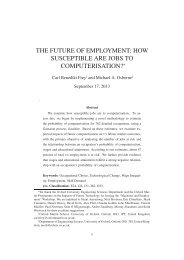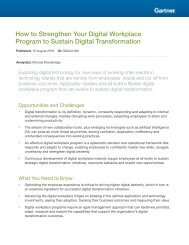THE FUTURE OF EMPLOYMENT: HOW SUSCEPTIBLE ARE JOBS TO COMPUTERIZATION?
We examine how susceptible jobs are to computerization. To assess this, we begin by implementing a novel methodology to estimate the probability of computerization for 702 detailed occupations, using a Gaussian process classifier. Based on these estimates, we examine expected impacts of future computerization on US labor market outcomes, with the primary objective of analyzing the number of jobs at risk and the relationship between an occupation’s probability of computerization, wages and educational attainment. According to our estimates, about 47 percent of total US employment is at risk. We further provide evidence that wages and educational attainment exhibit a strong negative relationship with an occupation’s probability of computerization.
We examine how susceptible jobs are to computerization. To assess this, we begin by implementing a novel methodology to estimate the probability of computerization for 702 detailed occupations, using a Gaussian process classifier. Based on these estimates, we examine expected impacts of future computerization on US labor market outcomes, with the primary objective of analyzing the number of jobs at risk and the relationship between an occupation’s probability of computerization, wages and educational attainment. According to our estimates, about 47 percent of total US employment is at risk. We further provide evidence that wages and educational attainment exhibit a strong negative relationship with an occupation’s probability of computerization.
Create successful ePaper yourself
Turn your PDF publications into a flip-book with our unique Google optimized e-Paper software.
Louis, P. and Paterson, G. (1986). Biased technical change, scale, and factor<br />
substitution in American industry, 1850-1919. The Journal of Economic<br />
History, vol. 46, no. 1.<br />
Lucas, R.E. and Prescott, E.C. (1974). Equilibrium search and unemployment.<br />
Journal of Economic Theory, vol. 7, no. 2, pp. 188–209.<br />
CAA (2012). Roadside assistance customers benefit from smart support during<br />
peak and after hours. Tech. Rep., SmartAction case study of Canadian<br />
Automobile Association Saskatchewan.<br />
IFR (2012a). 68 robots perform farmer’s work. Tech. Rep., Case study of<br />
Fanuc Robotics Europe S.A., International Federation of Robotics, September<br />
2012.<br />
IFR (2012b August 30). World robotics 2012. Tech. Rep., International Federation<br />
of Robotics.<br />
MGI (2011). An economy that works: Job creation and America’s future. Tech.<br />
Rep., McKinsey Global Institute.<br />
MGI (2013). Disruptive technologies: Advances that will transform life, business,<br />
and the global economy. Tech. Rep., McKinsey Global Institute.<br />
Mantoux, P. (2006). The industrial revolution in the eighteenth century: An<br />
outline of the beginnings of the modern factory system in England. Taylor &<br />
Francis US.<br />
Margo, R.A. (2000). Introduction to wages and labor markets in the United<br />
States, 1820-1860. In: Wages and Labor Markets in the United States, 1820-<br />
1860, pp. 1–5. University of Chicago Press.<br />
Markoff, J. (2011 March 4). Armies of expensive lawyers replaced by cheaper<br />
software. The New York Times.<br />
Markoff, J. (2012 August 18). Skilled work, without the worker. The New York<br />
Times.<br />
Mathibela, B., Osborne, M.A., Posner, I. and Newman, P. (2012). Can priors<br />
be trusted? learning to anticipate roadworks. In: Intelligent Transportation<br />
53





